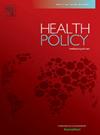使用社会投资回报方法评估高收入国家综合长期护理:范围审查
IF 3.4
3区 医学
Q1 HEALTH CARE SCIENCES & SERVICES
引用次数: 0
摘要
背景:有复杂护理需求的老年人越来越多,这突出表明迫切需要改善保健和社会服务之间的协调,强调综合护理模式的重要性。社会投资回报(SROI)框架是评估医疗保健干预措施(包括综合长期护理(LTC)解决方案)的社会、经济和环境影响的宝贵工具。然而,在专门分析其在综合LTC干预措施中的应用的综述中仍然存在空白。目的研究如何使用SROI来评估综合LTC干预措施,特别是对老年人。方法通过MEDLINE、CINAHL、谷歌Scholar和引文检索,对2012年1月至2024年6月的同行评议文献和灰色文献进行范围综述。三名独立审稿人根据PRISMA指南评估研究资格。使用PICOS术语提取数据,并组织成详细说明研究特征和SROI结果的汇总表。结果在556篇筛选论文中,只有11项研究符合纳入标准,其中大多数在英国进行。社会投资回报率的评估侧重于个人和社区资源,如改善身心健康和社会联系,而公共资源的好处,包括减少医疗工作量,在七项研究中得到了注意。金融代理来自HACT社会价值银行和全球价值交换等来源。所有的研究都报告了正的SROI比率,尽管方法上的局限性影响了解释。SROI在综合LTC中的应用仍然有限,主要基于英国,依赖于特定情境的方法。扩大其使用需要标准化的方法、更广泛的地理代表性和本地化代理,以便进行更准确的评估。本文章由计算机程序翻译,如有差异,请以英文原文为准。
The use of social return on investment approaches to evaluate integrated long-term care in high-income countries: A scoping review
Background
The increasing number of older adults with complex care needs underscores the urgent need for improved coordination between health and social services, emphasizing the importance of integrated care models. The Social Return on Investment (SROI) framework is a valuable tool for evaluating the social, economic, and environmental impact of healthcare interventions, including integrated long-term care (LTC) solutions. However, a gap remains in reviews specifically analyzing its application to integrated LTC interventions.
Objective
To examine how SROI has been used to evaluate integrated LTC interventions, particularly for older adults.
Methods
A scoping review of peer-reviewed and grey literature was conducted, covering January 2012 to June 2024, through MEDLINE, CINAHL, Google Scholar, and citation searches. Three independent reviewers assessed study eligibility, following PRISMA guidelines. Data were extracted using PICOS terms and organized into summary tables detailing study characteristics and SROI findings.
Results
Out of 556 screened papers, only 11 studies met the inclusion criteria, with most conducted in the UK. SROI evaluations focused on Personal and Community Resources, such as improved physical and mental health and social connections, while Public Resource benefits, including reduced healthcare workloads, were noted in seven studies. Financial proxies came from sources like HACT Social Value Bank and Global Value Exchange. All studies reported positive SROI ratios, though methodological limitations affect interpretation.
Conclusions
The application of SROI to integrated LTC remains limited, primarily UK-based and reliant on context-specific methodologies. Expanding its use requires standardized methods, broader geographic representation, and localized proxies for more accurate evaluations.
求助全文
通过发布文献求助,成功后即可免费获取论文全文。
去求助
来源期刊

Health Policy
医学-卫生保健
CiteScore
6.40
自引率
6.10%
发文量
157
审稿时长
3-8 weeks
期刊介绍:
Health Policy is intended to be a vehicle for the exploration and discussion of health policy and health system issues and is aimed in particular at enhancing communication between health policy and system researchers, legislators, decision-makers and professionals concerned with developing, implementing, and analysing health policy, health systems and health care reforms, primarily in high-income countries outside the U.S.A.
 求助内容:
求助内容: 应助结果提醒方式:
应助结果提醒方式:


